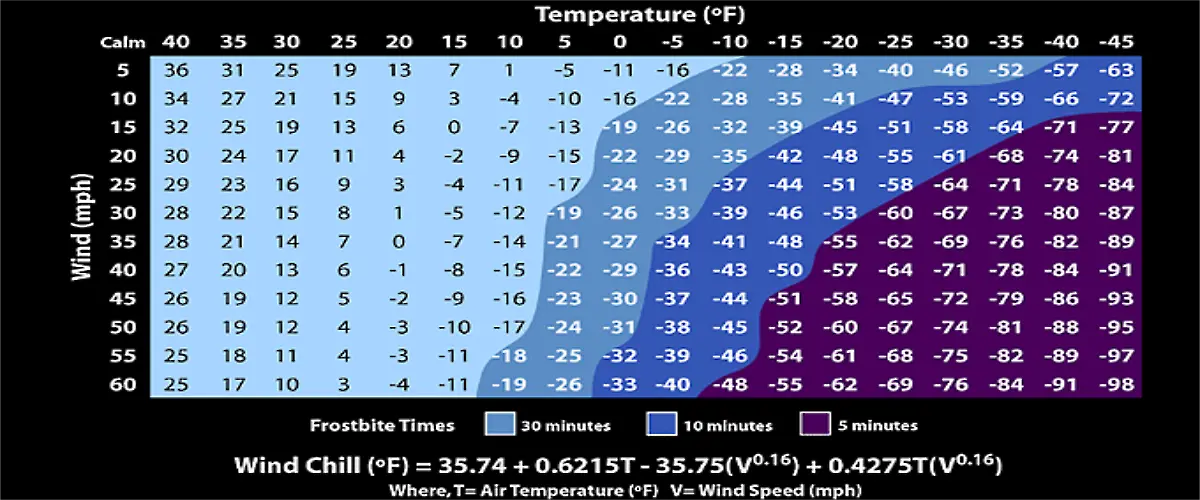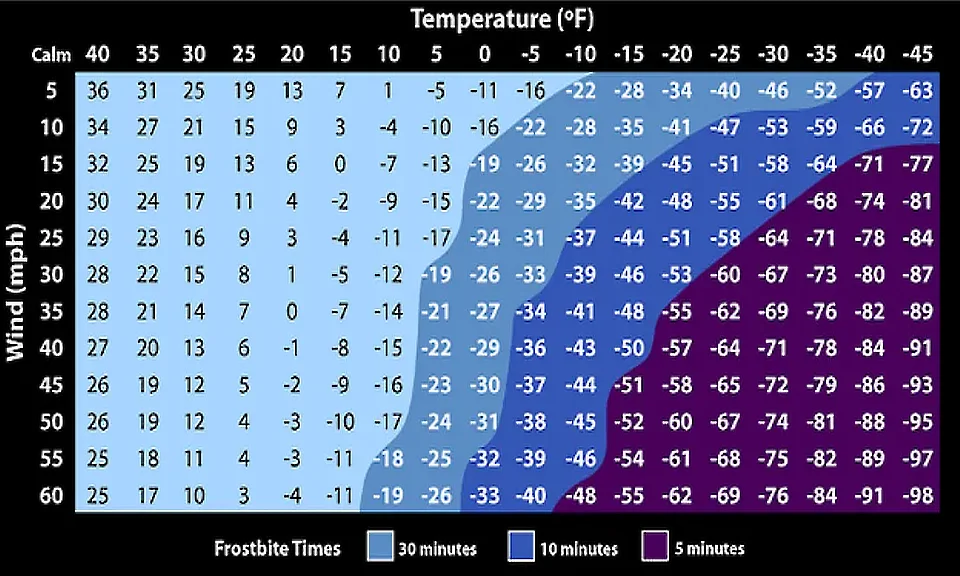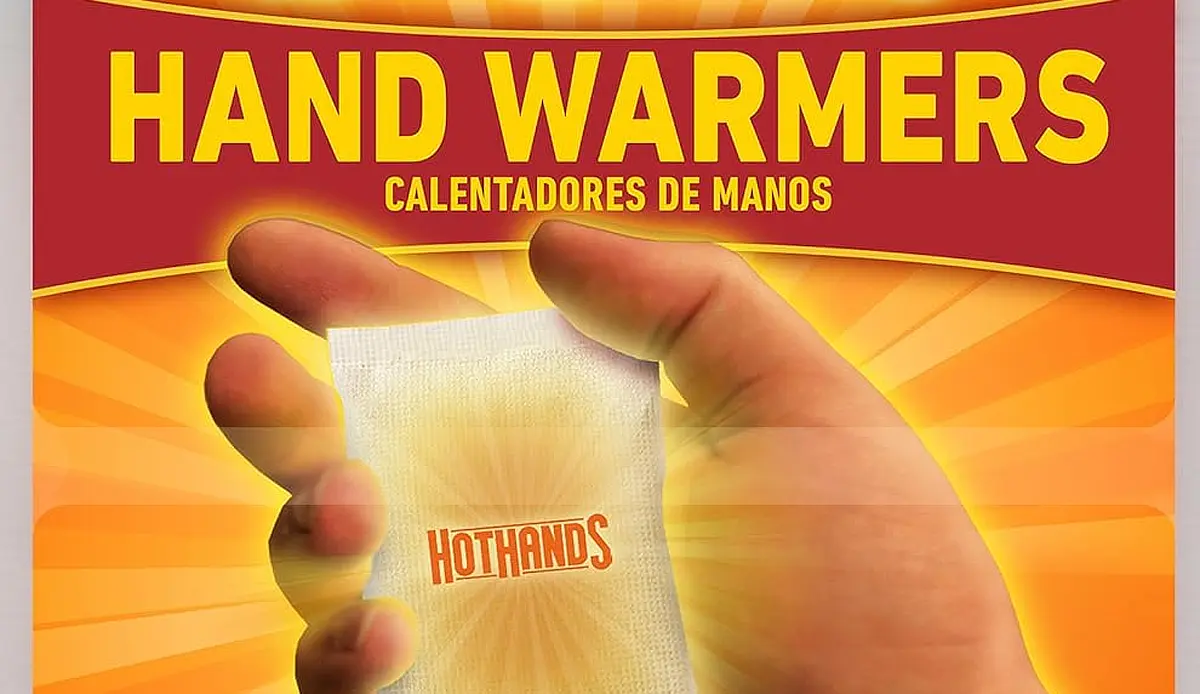Wind Chill Frostbite Chart – Time vs Temperature

Based on National Weather Service wind chill frostbite chart data and ‘Defence R&D Canada – Toronto’ data, here is a wind chill frostbite chart and time-to-frostbite versus temperature guide:
Wind Chill Frostbite Hazard
Wind Chill Temperature versus Time to Frostbite:
(temperatures in degrees-F)
32 to 16 (Low Risk)
14 to -17 (Moderate Risk)
-18 to -38 (High Risk) 10 to 30 minutes
-40 to -52 (Very High Risk) 5 to 10 minutes
-54 to -65 (Severe Risk) 2 to 5 minutes
-67 and colder (Extreme Risk) less than 2 minutes
Note that time to frostbite increases more quickly when wind chill temperatures fall below -17.
Frostbite Chart
The wind chill chart shown below is a temperature index which accurately indicates how cold the air feels on human skin.
The wind chill chart also includes a frostbite indicator. This reveals the temperatures at which wind speed coupled with skin exposure time will produce frostbite.
Wind Chill Temperature and Time to Frostbite:
Intersect or cross reference the top horizontal line (air temperature) with the wind speed along the left side vertical axis.
To find frostbite time, compare the cross referenced wind chill temperature with the color shade. The shaded colors represent a range of time to frostbite:
0 – 5 minutes (PURPLE)
5 – 10 minutes (dark blue)
10 – 30 minutes (blue)

Full-size wind chill frostbite chart (PDF)
Examples using the wind chill chart:
- An air temperature of 0°F with a wind speed of 15 mph will result a wind chill temperature of -19°F. Under these conditions, exposed skin will freeze ( frostbite ) in approximately 30 minutes!
- On a frozen lake while ice fishing with air temperatures hovering between 5°F and 0°F. The wind isn’t terribly strong, but steady across the lake 10-15mph. Guess what… you’re exposed skin might freeze with frostbite in about 30 minutes…
I ALWAYS have a supply of these particular ‘Hot Hands’ hand warmers and toe warmers. Simple and effective to use! Fits in your gloves and/or in your boots.

I may earn commission (no extra cost) if purchased.
Thank you
What is Wind Chill Temperature?
Wind chill is the “feels like” temperature. It’s based on the rate of heat loss from exposed skin caused by the effects of wind and cold. As the wind increases, the body is cooled at a faster rate causing the skin temperature to drop.
Wind chill does not impact objects that are ‘not alive’ like car radiators and exposed water pipes, because these objects cannot cool below the actual air temperature.
What is Frostbite?
Frostbite is an injury to the body caused by freezing body tissue. The most susceptible parts of the body are the extremities such as fingers, toes, ear lobes, or the tip of the nose.
Symptoms include a loss of feeling in the extremity and a white or pale appearance. Medical attention is needed immediately for frostbite. The area should be SLOWLY re-warmed.
What is Hypothermia?
Hypothermia is abnormally low body temperature (below 95 degrees Fahrenheit). Warning signs include uncontrollable shivering, memory loss, disorientation, incoherence, slurred speech, drowsiness, and apparent exhaustion. Medical attention is needed immediately. If it is not available, begin warming the body SLOWLY.
[ Read: How To Prevent Frostbite, Hypothermia ]
Cold Weather Tips
Hand and Foot Warmers
From experience I can tell you that these hand and toe warmers work very well! I always keep a box of each. When activated they stay warm for about 6 – 8 hours! (linked above)
Avoid Cotton
Cotton soaks up water. Cotton clothes, especially worn as a first layer, will hold onto water for a long time. When cotton clothes get wet, they stay wet. Better choices include synthetic materials. Breathable.
Layers
Wear layers of loose fitting warm clothing. Trapped air between layers provides insulation.
Outerwear
Outer garments should be tightly woven, water repellent, and hooded.
Face, Eyes, Head
Goggles to protect your eyes and part of face. Wear a hat! Apparently 40% of your body heat can be lost from your head. Wear a face mask to cover your mouth, nose, and protect your lungs.
Hands
Good warm gloves/mittens!
[ Read: Best Gloves With Thinsulate Insulation ]
Clean Clothes
Dirty clothes clog the insulating properties.
Sweating
Avoid overheating. When you sweat you loose heat faster.
Keep Active
Generate body heat without overheating (sweating).
Keep dry
Water, sweat, dampness will pull the heat from your body.
[ Read: The Warmest Survival Blanket – Wool Or Polar Fleece? ]

